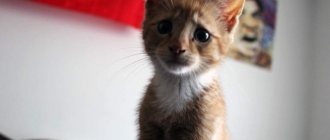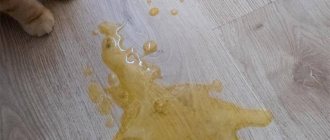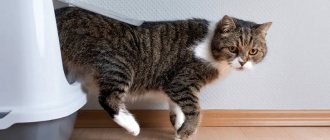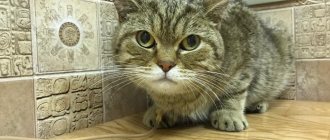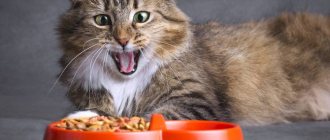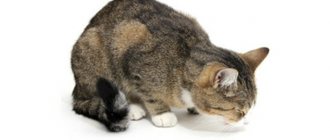It's not uncommon to see your cat vomiting. It just so happens that our pets eat grass (any kind of grass, not “medicinal” grass) specifically for this purpose. In this way they get rid of the “junk” accumulated in the digestive organs.
But if a cat vomits bile, this is already a cause for alarm, because this phenomenon does not occur “just like that,” and in most cases it indicates some serious problems with the digestive organs.
Cat's vomit is yellow
Almost all owners panic when their cats vomit yellow liquid. But you need to pull yourself together and observe how often this happens.
If yellow vomit occurs once and there are no other symptoms, a visit to the veterinarian is not required. However, if a cat vomits yellow liquid for several hours or days, he needs to be seen by a specialist immediately - this indicates the accumulation of too much bile in the stomach.
In a kitten, vomiting yellow liquid usually occurs in the presence of congenital pathologies of the digestive organs. This condition requires immediate medical attention. After all, the smaller the kitten, the higher the likelihood of its death due to dehydration. Babies older than 3 months have a higher survival rate in this situation.
Important! Bile can eat away at the stomach lining. Its prolonged accumulation in the stomach leads to the development of inflammation of the digestive organs and even the appearance of ulcers.
Causes of blood in stool
Often, the reasons that lead to the appearance of blood in the stool are associated with disorders of the gastrointestinal tract.
Disorders that are accompanied by the appearance of feces containing blood in a cat:
- peptic ulcer;
- poisoning;
- malignant or benign neoplasms;
- kidney dystrophy, pancreatitis;
- allergic reaction;
- eating disorders;
- foreign body in the stomach.
These diseases require treatment under the supervision of a veterinarian. If constipation is treated by switching to a dietary diet, then some pathologies cannot be eliminated without medication or surgery.
There are also a number of diseases in which blood may appear in the stool.
- Melena or tarry stools. The pathology is accompanied by bleeding that occurs in the lower intestine. It can be caused by an ulcer or damage to the digestive tract. Other signs also appear: she refuses to eat, behaves apathetically, hunches over, and vomits.
- Colitis. The disease can be accompanied by both constipation and diarrhea, and yellow vomiting. The cat neither eats nor drinks. What to do with such a pathology? Contact a specialist immediately.
- Toxic infections. When poisoned with hemolytic poisons, the animal hides in a dark corner, often vomits, refuses to eat and behaves apathetically. He may experience an increase in body temperature.
- Helminthiases. Accompanied by copious and frequent vomit (including worms), stomach upset (constipation or diarrhea), mucous membranes become yellow, conjunctivitis appears, and breathing is heavy. At the same time, the cat also experiences a decrease in the amount of hair and weight loss.
All these pathologies require timely therapy, since its absence can lead to the development of peritonitis, anemia and even death.
The mechanism of the gag reflex
Usually, owners believe that the cat vomited due to coughing. In fact, it is a symptom of vomiting, not a cause. The attack usually proceeds as follows:
- The cat appears to have increased salivation. She worries, constantly licks herself and swallows the saliva that forms.
- Then a cough begins, the animal breathes frequently and deeply, and stretches its head forward.
- The area of the pharynx and abdomen contracts, first fruitless vomiting appears, and then with the contents.
Important! For cats, vomiting every 3-4 days is normal.
Most often, cats vomit when they eat too quickly or eat too much. This often happens when feeding with low-quality industrial feed or with a mixed diet. Vomiting may also appear in the morning if the cat fell asleep hungry the day before.
If vomiting occurs from overeating, you just need to not let your pet eat or drink for 8 hours, and instead of water, offer to lick an ice cube. If a cat systematically vomits due to an incorrectly formulated diet, it needs to be reconsidered.
All long-haired cats also suffer from nausea and vomiting. When licked, the fur enters the stomach, where it gradually rolls into lumps, which cause irritation of the gastrointestinal tract. This is why burping fur should not be a concern. If there is blood, foam or mucus in the vomit, you should immediately contact the clinic.
First aid
A veterinarian is involved in finding the causes and treating vomiting in a yellow cat. But what if you have to travel far to get there? How to provide first aid to your beloved pet? To begin with, it is worth eliminating the development of dehydration, which can occur with excessive vomiting or diarrhea. You need to force the cat to drink as much as possible. Give a small amount of water every half hour. It is also worth not feeding the animal, but putting it on a fasting regime for at least 24 hours.
It is not recommended to give your pet antiemetic medications that are intended for use on your own. If the vomiting does not stop for more than a day, you should contact a veterinarian to eliminate the causes. But before that, you can only alleviate the unpleasant symptoms. Especially when the cat has diarrhea, yellow vomit, and neither eats nor drinks.
What to do and how to alleviate the animal’s condition:
- if the vomit contains lumps of hair or food that has not been digested by the stomach, it is worth holding off on feeding for now; you can only give water;
- with frequent belching, which is somewhat similar to vomiting, it is worth reviewing the diet, namely, removing canned food, sweets and fatty foods;
- Chamomile decoction will help restore peristalsis and normalize the functioning of the gastrointestinal tract (1 tsp is given up to four times every morning).
This first aid can help if the pet does not have serious problems with the liver, gall bladder or other pathologies of internal organs.
Causes of yellow vomit in cats
The correct diagnosis largely depends on the reasons why the cat is vomiting yellow liquid. If the owner remembers when the cat vomited for the first time, and how often it happened in the future, this will help in diagnosis.
Reasons why a cat vomits bile:
- Foreign body in the stomach. Often, while playing, kittens accidentally swallow small objects. If the item eaten is very small, it will pass out with the feces without any problems. If it is quite large in size, the cat’s body will begin to actively produce bile to speed up the digestive process. As a result, the cat will begin to feel nauseated, and along with the vomit, it will regurgitate excess bile.
- A sudden change in diet. Sometimes owners decide to switch their cat to a more nutritious and high-calorie food. If there is a sudden transition, he will vomit yellow liquid with the presence of remnants of undigested food. This is due to the fact that the liver's work slows down in such a situation, as it is not able to digest too much fatty food.
- Worm infestation. Helminthiasis is one of the most common causes of yellow liquid vomiting in cats. The body tries to rid itself of parasites, as in the case of a foreign body. Worms cause serious disturbances in the functioning of the digestive system. As a result, the cat vomits bile and does not eat anything.
- Gallbladder diseases. With any abnormalities and pathologies in the functioning of the gallbladder, cats usually vomit yellow liquid with foam and a distinct odor of bile. Sometimes diarrhea mixed with bile and blood appears. In such a situation, you should immediately go to the veterinarian.
- Pregnancy. During pregnancy, all existing diseases in the cat will worsen. Some pregnant cats vomit yellow liquid. This indicates that they have problems with the gallbladder and its ducts.
- Infectious diseases. Vomiting of yellow liquid can be observed in cats with hepatitis, herpes, rhinotracheitis, panleukopenia (feline distemper). In addition to this symptom, weakness, watery diarrhea, and bad breath are observed. A pet can vomit not only after eating, but also on an empty stomach.
- Postoperative period. Sometimes cats may experience complications after various operations. Vomiting of yellow liquid mixed with blood, foam, brown or green mucus appears. The cat becomes inactive, and his health rapidly deteriorates. The animal's nose remains dry and warm, the fur loses its shine and begins to roll into lumps. In case of any postoperative complications, you must show your pet to a doctor who will select the necessary treatment for him.
Important! Large objects eaten by a cat cannot be removed by its intestines, so the pet may well experience a blockage in the stomach or esophagus. If you accidentally swallow various objects, it is better to play it safe and take your cat to see a veterinarian.
Important! Heartworm infection can also be a reason why your cat is vomiting bile.
What does each discharge indicate when vomiting occurs?
If your pet has vomited a couple of times at most and is feeling quite normal, there is no need to panic. This can be caused by intestinal irritation, which occurs due to swallowing fur or a large clump of grass. In this case, it is recommended to monitor the pet’s condition for one day and then look for the reasons for the deterioration of its health.
The cat may vomit bile, as indicated by the yellow color, and may also suffer from other discharges. Regular vomiting of a rich yellow or green hue primarily indicates that there are problems in the functioning of the liver or kidneys. There may also be stomach problems.
Blood present in the vomit may indicate that the esophagus or pharynx has been damaged by some sharp object, such as a fish bone.
Associated symptoms
Yellow vomiting in a cat may be accompanied by additional symptoms depending on the cause that led to its appearance:
- the presence of hairballs, food particles, foam in the vomit;
- refusal to eat;
- deterioration in wool quality;
- constipation.
If you are repeatedly vomiting yellow liquid, you should give your cat something to drink as often as possible. If he does not drink on his own, it is recommended to pour liquid into his mouth every half hour to prevent dehydration. There is no need to feed the cat during this period.
Important! It is strictly forbidden to give your cat antiemetic drugs without a doctor's prescription.
If your pet's condition does not improve within a day, you should take him to the veterinarian.
Why does my cat feel sick and vomit?
Your veterinarian will ask many questions to determine why your cat is vomiting.
This includes:
- Have you recently changed your cat's diet?
- Have you started taking any prescription or over-the-counter medications?
- What diet, including all treats, is your cat on?
- Do you have other cats in the house, and if so, do they vomit too?
- Is your cat indoors and/or outdoors?
- How often does your cat vomit and what does it look like?
- Does your cat keep eating?
- Does your cat have other symptoms, such as diarrhea and/or weight loss?
- How long has your cat been vomiting?
There are several possible causes of vomiting in cats, and these questions will help point your veterinarian in the right direction. Possible causes of vomiting in cats can be divided into two categories: gastrointestinal causes and non-gastrointestinal causes.
Gastrointestinal causes of vomiting in cats
- Indiscretion in nutrition
- Foreign bodies
- Parasites
- Diet hypersensitivity
- Inflammatory bowel disease
- Constipation
- Cancer
- Ulceration
- Ingestion of toxins (ethylene glycol, chocolate, pesticides, etc.)
Causes of vomiting in cats not related to the gastrointestinal tract
- Pancreatitis
- Kidney disease
- Liver disease
- Diabetes
- Feline infectious peritonitis
- Cancer
- Neurological diseases
When you need to see a doctor urgently
Sometimes a cat develops symptoms that signal that the animal requires immediate professional help:
- Frequent vomiting that lasts more than 5–10 hours. If your cat has vomited more than once and is constantly thirsty, she most likely has kidney problems.
- Temperature increase.
- Weakness and apathy.
- Very unpleasant smell of vomit and the same smell from the mouth.
- Diarrhea.
- Convulsions or fainting.
- Presence of blood or mucus in the vomit.
- Refusal of water and food. If your cat is vomiting but refuses to eat and loses weight, you may have lipidosis. With this pathology, too much fat accumulates in the liver area. As a result, the functioning of most organs is disrupted, and toxins accumulate in the body itself. A cat showing signs of lipidosis must be hospitalized as soon as possible, otherwise it will die.
- Fountain vomiting.
- Darkening of urine.
- Yellowness of the mucous membranes.
- Problems with passing urine. Sometimes, when vomiting and increased thirst, cats practically do not go to the toilet. This most often occurs when the animal's urinary tract is blocked by stones or worms. In such a situation, urgent surgical intervention will save the cat from death.
Symptoms
The appearance of yellow, foamy vomiting in a cat may be accompanied by other symptoms, which indicates disturbances in the functioning of orgasm. Often there is a refusal to eat, an increase in body temperature, dark urine, diarrhea and yellowing of the mucous membranes.
Vomit with a strong, unpleasant odor may indicate acute or chronic liver failure. With this pathology, yellowing of the sclera, fainting, and an unpleasant odor from the mouth can be observed.
If toxic elements accumulate in the liver for a long time, this ultimately leads to inflammation (lipidosis). There is also such a disease as feline distemper, which is accompanied by a sharp rise in temperature to 41 degrees, apathy, frequent diarrhea and vomiting. At the same time, the cat constantly walks hunched over.
Diagnostic measures
In a veterinary clinic, if a yellow liquid is vomiting, the doctor will carefully examine the cat, palpate its stomach, check its mucous membranes and measure its body temperature. Next, he will need detailed information about the cat’s condition, as well as documents with notes on vaccination, deworming and previous diseases.
To make a correct diagnosis, the following manipulations are usually performed:
- X-ray of the intestines, liver, bladder;
- CT scan;
- Ultrasound of internal organs;
- endoscopy;
- biochemical and general blood test;
- analysis of stool, vomit and urine.
Owners should not refuse diagnostic measures, because they are all aimed at saving the cat’s life. Unfortunately, even modern diagnostic methods do not always make it possible to find out the causes of vomiting yellow liquid, so they often complement each other. For example, ultrasound and x-rays will not help determine poisoning, and also do not always show acute inflammatory processes in the gallbladder and liver. This is why doctors prescribe additional tests.
Treatment and prevention
If a pet's health worsens, the owner should not treat it themselves. In this case, the risk of complications as a result of incorrectly selected methods and means increases.
An experienced specialist can accurately diagnose and prescribe therapy, taking into account the animal’s condition and the severity of the disease.
Providing first aid to a cat who is vomiting
It is useful for the owner to know what first aid is for a pet.
But any assistance actions can only be carried out under the following conditions:
- the cat looks healthy;
- nausea recurred once;
- there are no additional signs of deterioration in health.
Help may include the following:
- Do not give the animal food or water. Fasting for 24 hours will allow the body to rest and regain strength. To quench your thirst, you can give a piece of ice to lick.
- After a day, you can start feeding him food with a slimy consistency.
- A return to regular food occurs after a couple of days.
- If you suspect poisoning or ingestion of a foreign body, you should induce a vomiting attack. In case of poisoning, such vomiting will only help in the first couple of hours. This will stop the action of toxins, but if a lot of time has passed, they have already entered the bloodstream.
- When worms appear, an antihelminthic drug must be given.
No owner is immune from the deterioration of a pet's condition.
If your health deteriorates significantly, you should immediately contact your veterinarian.
Following simple rules of care will help reduce the likelihood of vomiting attacks:
- feed only fresh food;
- give food in small portions in several doses;
- give preventive vaccinations;
- give antihelminthic drugs annually;
- pets with long hair should be combed with special brushes and given medications to improve the natural elimination of hairballs from the body;
- remove all small objects from reach;
- Periodically visit the veterinarian for a preventive examination.
When medical help is urgently needed
If your health deteriorates significantly, you should immediately contact your veterinarian.
Dangerous symptoms may include the following:
- attacks of nausea continue for several days;
- vomiting appears several times a day;
- foreign impurities appear (bile, foam, blood);
- attacks of nausea appear even between meals;
- there are other symptoms - increased or decreased body temperature, diarrhea, discharge from the nose or eyes, weakness.
Be sure to read:
A cat pees with blood: causes, first aid, how to treat it at home, consequences
The doctor examines the animal and asks the owner about all the details of the deterioration of his health condition. Detailed answers allow the specialist to make a diagnosis and prescribe treatment.
In some cases, additional examinations may be performed - ultrasound, gastroscopy, blood tests or x-rays.
Diseases of the gastrointestinal tract and genitourinary system
Most experts believe that the appearance of nausea in pets, as a rule, is a consequence of improper care and nutrition.
If a pet is diagnosed with gastrointestinal pathologies, diet and medications are used.
Depending on the cause of vomiting, the following may be used:
- rehydration preparations to restore the body’s water balance;
- antiemetics to improve well-being;
- antibiotics to fight bacteria;
- sorbents for cleansing of toxins;
- phytotherapy.
In severe cases, surgery is used. With the help of operations, large bezoars, kidney stones, foreign objects are removed, and large injuries to internal organs are sutured.
When vomiting bile is not dangerous
If during the molting period you notice that your cat is vomiting, then you need to brush it more often.
There are quite “real life” situations when the appearance of vomiting with bile is normal, and the owners have nothing to worry about:
- For cats, a natural behavioral response is to groom their fur with their tongue. It is not surprising that over time a fair amount of hair . To get rid of it, the body provokes a gag reflex.
- Sometimes a similar reaction occurs in animals after undergoing surgery , in particular after sterilization.
- Feed the cat once a day , and very generously, with dry food. A very common situation is when owners are at work all day and cannot feed the cat more often, but in smaller portions. Special automatic feeders will help save the situation, which would “give out” additional food to the pet 1-2 times between the main feedings in the morning and evening.
Feed your cat more often, but less food
Try to feed your cat more often, but in a balanced manner. There is no need to fill the bowl with a heap. Neutered cats may overeat.
In this case, it is important not to forget the basic rule - the more often the cat receives food, the less amount should be eaten at one time. As a compromise, food specifically designed for single feeding of cats is also suitable.
Their composition is not only balanced in all important components, but also contains a lot of dietary fiber.

